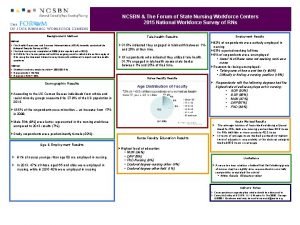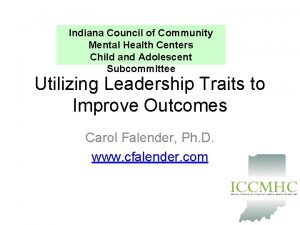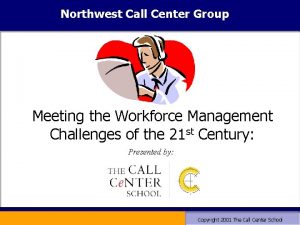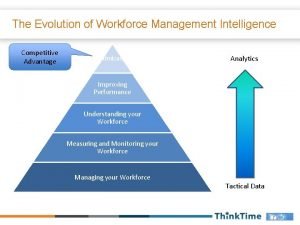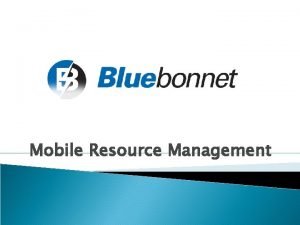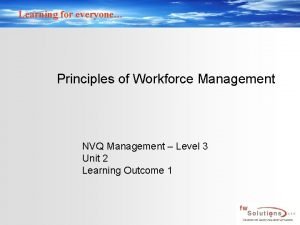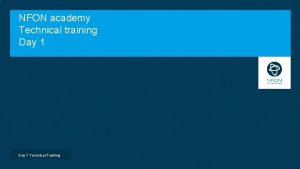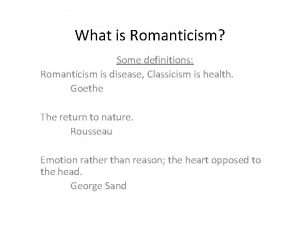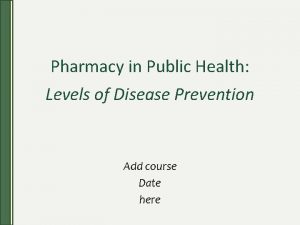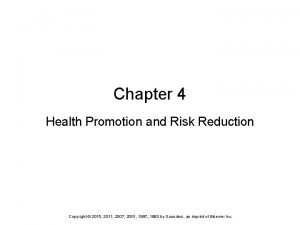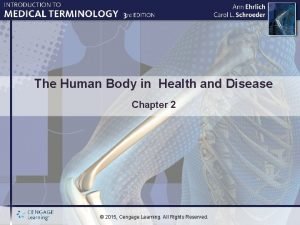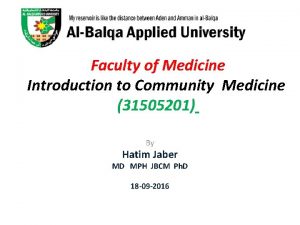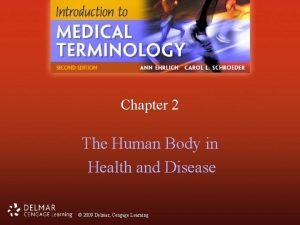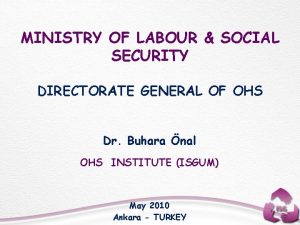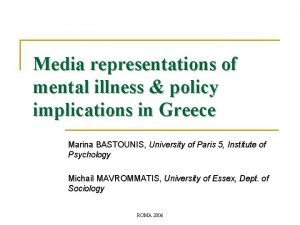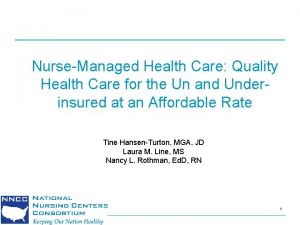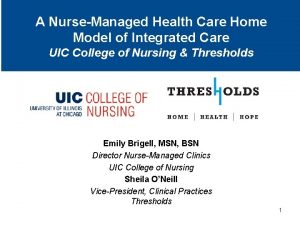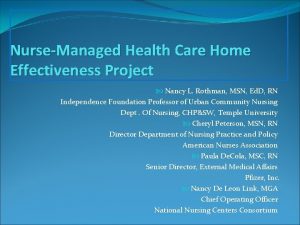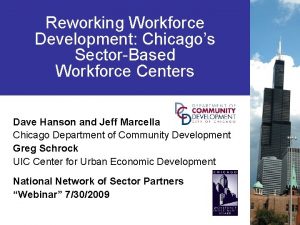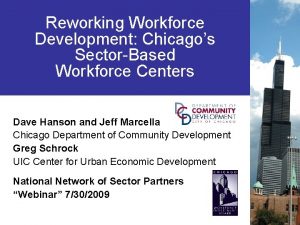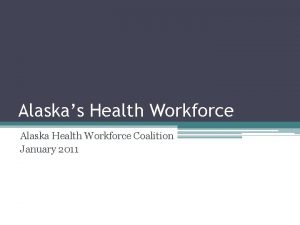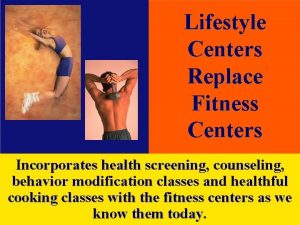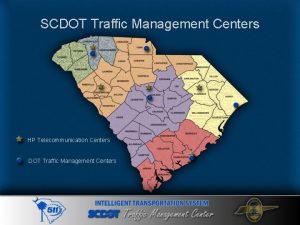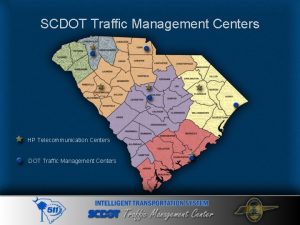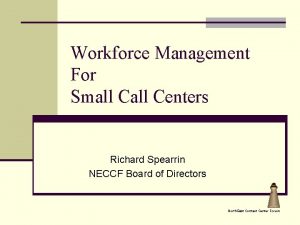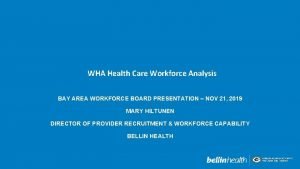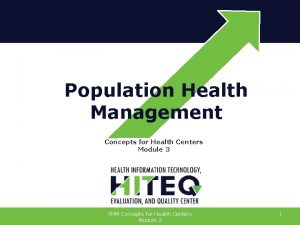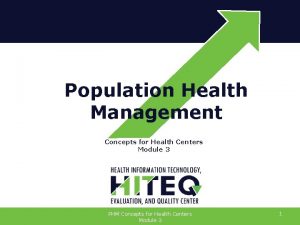NurseManaged Health Centers The New Disease Management Workforce






























- Slides: 30

Nurse-Managed Health Centers: The New Disease Management Workforce

NNCC - Who We Are/Background: VISION: Keep the nation healthy through nurse-managed care. MISSION: To strengthen the capacity, growth and development of nurse-managed health centers to provide access to quality care for vulnerable populations and to eliminate health disparities. The Consortium: • Began in 1996 as a regional organization& went National in 2002 • Serve 190 member nurse-managed health centers in the U. S. Our Member Centers: • Over 2. 5 million health center patient encounters annually & growing • Reside in both rural, urban & suburban locations • Provide Primary Care, Health Promotion & Disease Prevention • Are Run by Advanced Practice Nurses • Managed by Schools of Nursing, Non-profits and For-profit sector 2

Member Centers Are Community-Based Locations: public housing developments, churches, schools, community centers, and homeless or domestic violence shelters 3

Centers Offer a Diverse Staff of Health Professionals Health care providers: • Certified Registered Nurse Practitioners – 20% • Advanced Practice Nurses – 23% • RNs – 9% • Therapists and social workers – 6. 5% • Community outreach workers - 4% • Collaborating physicians -. 5% • Administrative Support Staff - 12% of total • Health educators, students and others – 25% 4

Member Centers Serve a Range of Clients 5

Member Centers Serve Clients Across All Age Groups 6

Patient Payor-Mix 7

Nurse-Managed Health Centers Outcomes in Primary Care Centers report: • High patient satisfaction • ER use 15% less than aggregate • Non-maternity hospital days 35 -40% less • Specialty care cost 25% less than aggregate • Prescription cost 25% less than aggregate • NMHCs see their members an average of 1. 8 times more than other providers 8

Reasons for Better Patient Outcomes • Location, Location: Services are accessible in the community where people live • More time with patient (nursing model of care) • Intensive case management • Affordable care & built-in incentives • Culturally appropriate services • Solicit input & listen to community needs/builds trust • Health promotion and disease prevention focus 9

Lead Safe Babies • Design – Scripted home visit education program with pregnant women and caregivers of children under one year of age – Pre/post-intervention tests of knowledge – Visual assessment of condition of home – Lead dust swipes – Lead blood levels 10

Lead Safe Babies • Philadelphia 2005 -06: N=2, 329 • CDC and HUD funded, includes interim control for homes with high lead dust levels • Incentives • Control group children living in same geographic area 11

Lead Safe Babies • Outcomes – Statistically significant increase in knowledge – 69% LSB children born within 6 months of enrollment had blood lead levels lower than the mean for the City – 71% LSB children living in high risk blocks had blood lead levels lower than the mean of the City 12

Asthma Safe Kids • Design – Scripted home visit education program with caregivers of children with asthma – Pre/post-intervention tests of knowledge – Visual assessment of condition of home 13

Asthma Safe Kids • Philadelphia 2004 -05: N=115 • Funded by EPA and STEPS to a Healthier Philadelphia • Incentives • Children used as their own control group 14

Asthma Safe Kids • Outcomes – Statistically significant increase in knowledge – Using mattress cover +85% – Using pillow cover +75% – Child not present when cleaning +45% 15

Emergency Room visits & Hospital Stays with in one year… • Emergency Room • Pre 17% • Post 11% • Hospital Stays • Pre 13% • Post 5% 16

Heart & Soul • Descriptive design • Exercise classes – Line Dancing – Tae Bo Health information Healthy Snacks Stroke screening Blood pressure screening 17

Heart & Soul • Philadelphia 2004 -05: N=120 • Funded by Edna G. Kynett Memorial Foundation • Incentives • Screenings 18

Heart & Soul • Outcomes – 120 African American women participated in exercise/line dancing – 11 health fairs held – 1, 100 newsletters distributed – 400 blood pressure and stroke screenings • • • 66% >140/90 Average 30 years 71% had family histories of hypertension 60% had family histories of diabetes 37% had family histories of high cholesterol 19

Heart & Soul Outcomes Before the intervention… – People did not know the difference between healthy and unhealthy blood pressure. – There were misconceptions about fat, sugar and salt in common foods. – Many believed rice and potatoes had high fat content. – Chicken was thought to include a lot of salt. After the intervention… – Knowledge in all areas increased. 20

Cognitive Therapy • Design – Series of classes for advanced practice nurses followed by application with clients and supportive conference calls – Pre/post assessment of nurses’ cognitive therapy awareness – Pre/post assessments of clients’ level of depression and anxiety 21

Cognitive Therapy • Philadelphia 2005: N=132 older adult patients, mean of 6 visits/patient • Funded by Pew Charitable Trust • Nurses and patients used as their own control groups. 22

Cognitive Therapy • Outcomes - Mean of nurses on Cognitive Therapy Awareness improved from 55%-82% - Patient depression scores were unchanged - Patient anxiety scores improved by 28% 23

Walk & Win • Design – A descriptive study of a walking program within senior housing or senior centers – Curricula were provided to undergraduate nursing students to allow the students to offer a standardized exercise intervention for older adults over eight weeks 24

Walk & Win • 2005: N= 62 students in 6 Pennsylvania nursing schools N=174 older adults in senior housing or senior centers • Funded by the Division of Nursing • Student nurses and older adults served as their own controls. 25

Walk & Win • Outcomes – Student nurses gained knowledge of nursing in the community, older adults and nursing centers, – Older adults had a statistically significant improvement in their knowledge about exercise and walking. – Older adults improved their mental and physical health, decreased their limitations due to physical or mental health, improved energy, social functioning and their perception of their health. Eighty-five percent said they would continue their walking. 26

Student Run: Philly Style • Design – Adolescents are introduced to distance running as a discipline that could transform their lives. – A descriptive design describes the knowledge gained related to health education, as well as data related to self-esteem, goal setting behaviors, grades, school attendance & graduation rates are sources for evaluation data. 27

Student Run: Philly Style • Philadelphia 2005 -06: N= 140 students; 40 leaders/coaches • Robert Wood Johnson funded with local matched funding from Beck Institute, Keystone Mercy Health Plan East, Independence Blue Cross, Independence Foundation, Philadelphia Foundation and, Samuel Fels Foundation, William Penn Foundation • Adolescents serve as their own control group. 28

Student Run: Philly Style • Outcomes - 10 -14% improved flexion - statistically significant improvement in self-esteem, social competence & knowledge related to smoking 29

NNCC Contact Information Tine Hansen-Turton, MGA CEO, National Nursing Centers Consortium VP, Philadelphia Health Management Corporation 260 South Broad Street, 18 th Floor Philadelphia, PA 19102 P: (215) 731 -7140/F: (215) 731 -2400 Tine@NNCC. US WWW. NNCC. US 30
 National forum of state nursing workforce centers
National forum of state nursing workforce centers Workforce transformation opwdd
Workforce transformation opwdd New centers of civilization
New centers of civilization Indiana council of community mental health centers
Indiana council of community mental health centers Health resource centers and libraries near pittsburg
Health resource centers and libraries near pittsburg Communicable disease and non communicable disease
Communicable disease and non communicable disease Cloud os for virtualized data centers
Cloud os for virtualized data centers Types of responsibility accounting
Types of responsibility accounting Call center school workforce management
Call center school workforce management Wfm impact 360
Wfm impact 360 Avaya workforce optimization
Avaya workforce optimization The evolution of workforce management
The evolution of workforce management Cayenta payroll management
Cayenta payroll management Mobile resource management solution
Mobile resource management solution Principles of workforce management
Principles of workforce management Voxtron pricing
Voxtron pricing Mynfon
Mynfon Classicism is health romanticism is disease
Classicism is health romanticism is disease Health promotion and levels of disease prevention
Health promotion and levels of disease prevention Health promotion and levels of disease prevention
Health promotion and levels of disease prevention The human body in health and disease chapter 2 answer key
The human body in health and disease chapter 2 answer key Biomedical concept of health
Biomedical concept of health Concepts of health and disease
Concepts of health and disease The human body in health and disease chapter 2 answer key
The human body in health and disease chapter 2 answer key Adenomalacia is the abnormal hardening of a gland.
Adenomalacia is the abnormal hardening of a gland. Conclusion for safety and health
Conclusion for safety and health Conclusion of health and disease
Conclusion of health and disease Hình ảnh bộ gõ cơ thể búng tay
Hình ảnh bộ gõ cơ thể búng tay Slidetodoc
Slidetodoc Bổ thể
Bổ thể Tỉ lệ cơ thể trẻ em
Tỉ lệ cơ thể trẻ em
